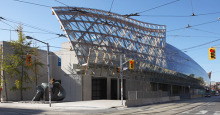Members of the Association of Art Museum Directors head to Toronto this weekend for the group’s semiannual meeting, Sunday through Wednesday. While they’re there, directors will be visiting not only the Art Gallery of Ontario — which last year opened its new Frank Gehry-designed space (at right) —
 but also the Albright-Knox Art Gallery and the new Burchfield Penney Art Center in nearby Buffalo.
but also the Albright-Knox Art Gallery and the new Burchfield Penney Art Center in nearby Buffalo.
On the agenda: the start of a new strategic plan for AAMD. Matthew Teitelbaum, director of the AGO, chairs the committee. They’ll also be talking about the economy and other undisclosed museum issues. (Survival, probably.)
The AAMD exists for the good of its members and not the press, of course, but sometimes our interests overlap. So, when I spoke the other day with Janet Landay (below), AAMD’s new executive director, I made a plea for more and better statistics. The AAMD surveys its 190 members each year in a State of North America’s Art
 Museum report — but the numbers it discloses are fairly useless. For example, if you read the report on 2008, you will discover that 20% of respondents increased their acquisitions in 2008 while 15 percent decreased them, and 63% had no change. Is that by number? Value? By what percent did they go up or down? It doesn’t say. Ditto for other questions. Here’s a link to the last report, on 2008, released on April 30 – you’ll see what I mean.
Museum report — but the numbers it discloses are fairly useless. For example, if you read the report on 2008, you will discover that 20% of respondents increased their acquisitions in 2008 while 15 percent decreased them, and 63% had no change. Is that by number? Value? By what percent did they go up or down? It doesn’t say. Ditto for other questions. Here’s a link to the last report, on 2008, released on April 30 – you’ll see what I mean.
Wouldn’t it be useful for the public to know how museums in general and their hometown museum in particular is doing in this climate?
When I brought this up with Landay, she agreed that the numbers “are useless” and said “we need to fix a lot of that. It’s on our agenda of things we are going to do.” We both need better and more frequent numbers. In March, I noted here that the Theatre Communications Group had started doing “Snapshot Surveys” of its members, some 460 theatres in 47 states, on fiscal matters. They aren’t perfect, but they are much more useful than AAMD’s statistics. Maybe TCG will share how it does it.
What else should be on AAMD’s agenda?
My wish list would include discussion, and maybe some guidelines, some benchmarks, about:
- Exhibition of single-owner collections. Many are great, and should be shown, but I hear tales of pressure on directors from collectors (often board members) who make no pledges or promises about donating any of the works on display, but benefit from the increase in value of their collections. Worse, some have been known to play museums off against one another, seeking better and better “deals.”
- Endowments. At least in the performing arts, an old rule of thumb mandated an endowment of three times the group’s annual budget (some say two times, recently) for a healthy organization. Why not a rule of thumb for art museums? I don’t know what it would be but, to quote an old management line, what gets measured gets done — if trustees knew their museum did not measure up to an industry standard, might they be more willing to contribute to an endowment, rather than a capital campaign? Might they be more willing to meet that annual commitment they promised when they joined the board? What if the annual AAMD survey disclosed how many — and which — museums failed to meet the benchmark?
- Use of permanent collections. Museums need to attract more visitors to the works they own, not just to special exhibitions. It’s hard to write a guideline for this, but it’s worth a discussion.
I am sure there are more issues, probably more critical ones, but these are on my mind at the moment.
Photo Credits: Art Gallery of Ontario; Association of Art Museum Directors
